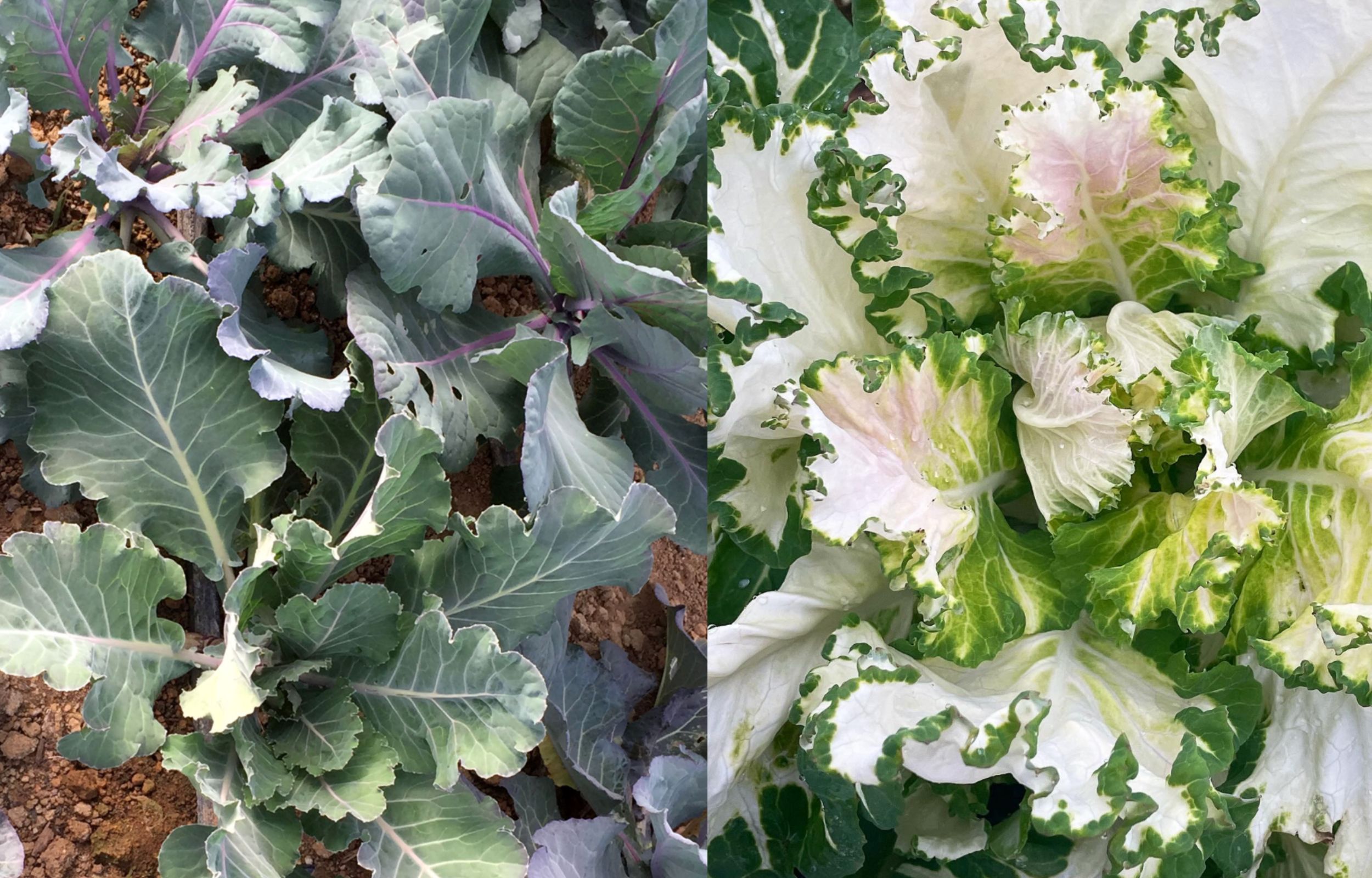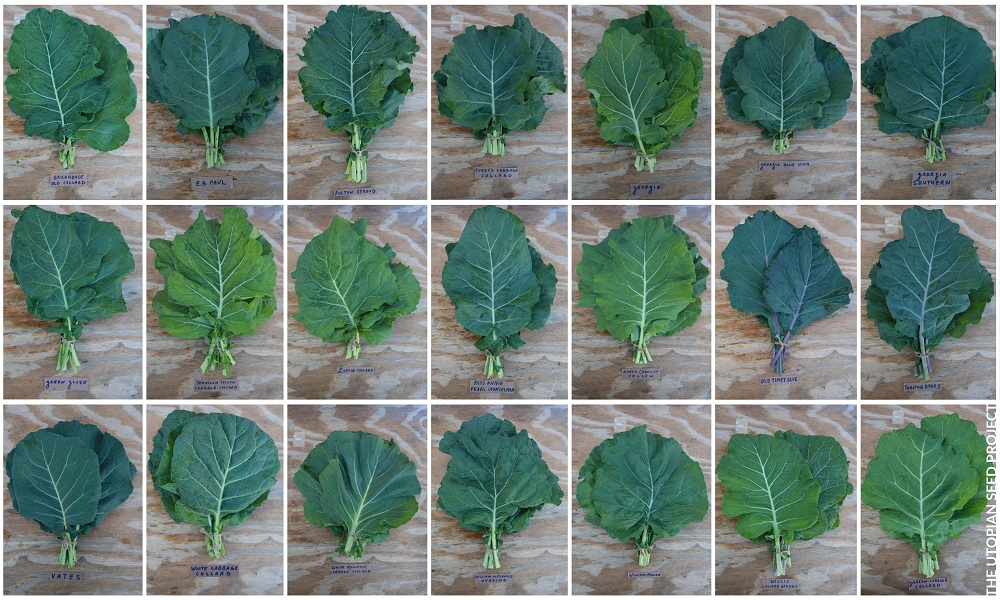Collards are one of our favorite greens here at Southern Exposure! They’re tasty garden workhorses that can handle the heat much better than many other greens. Unfortunately, they don’t seem to have gotten the same love that kale, spinach, moringa, and other greens have gotten, as we’ve seen a resurgence in local food.
This is so sad because collards have so much to give. In addition to being easy to grow, they contain impressive levels of calcium and vitamin K, both of which are essential for bone health. They’re also culturally significant.
Utopian Seed Project Founder Chris Smith got it right when he said, “It needs stating explicitly: We owe thanks to the enslaved African Americans who, robbed of their freedom and their homelands’ foods, adopted the collard and integrated it into gardens, kitchens, and therefore Southern foodways.”
So today, we’ll dive into the types of collards and how to grow and enjoy them!
Types of Collards
A collard is a collard? Generally, growers divide collards into six general categories. Though they are similar to grow, they have a few unique characteristics. Understanding these can help you find a suitable variety for your garden and taste.

Cabbage Collards
Cabbage collards typically have large light green or almost yellow leaves with large petioles. While they don’t create the same heads as cabbage, these varieties will often begin to form loose heads if left in the ground for an extended period. You may find that these varieties also have a more cabbage-like flavor than other collard greens. They make lovely sauerkraut! Many of these cabbage collards are from the Carolinas.
A great example of this type is Georgia Cabbage Collards (pictured above), an Heirloom Collard Project standout, originally from Bobby Prevatte, whose grandparents grew them near Lumberton, NC.

Colored Collards
Any variety of collards may have some unique color variation in its leaves, leaf veins, or petioles. As such, this category can overlap with the others. However, certain heirlooms were kept and known for their particularly unusual or vibrant coloration. Most commonly, collards are shades of green, greenish-yellow, or blue-green, but some varieties have rarer colors like red or purple.
Alabama Blue Collards (above left) and Variegated Collards (above right) are good examples of this type. Alabama Blue features green, blue-green, and purple leaves adorned with white, pale green, and plum-colored veins. Variegated Collards change color in cold weather. At least half the plants’ leaves become a beautiful green-and-white during the winter.

Curly Leaf Collards
Most collards have large, broad leaves with fairly smooth edges. These heirloom curly-leaf types usually have serrated edges that give them a more kale-like appearance.
Hen Peck (above) is one of these interesting varieties. It’s a North Carolina heirloom from Benny and Vickie Cox that features unusual toothed leaf margins that appear as if a bird had nibbled on them.

Glazed Collards
These collards share a glossy or glazed look. This appearance is caused by a gene mutation that controls the normal, waxy substance that covers the leaf surface. These glazed varieties appear shiny because they have less wax than other collards.
A great example is Green Glaze Collards (above), which were introduced in 1820 by David Landreth. Green Glaze features smooth, bright green leaves.

Heading Collards
Just as the name suggests, heading collards tend to start forming loose, cabbage-like heads as they mature. They tend to have shorter petioles than other varieties, which allows the leaves to curl into a head easily.
We are currently offering William Alexander Heading Collards (above). This heirloom was one of the first releases from the Collard Project. It comes from 79-year-old black farmer William Alexander, who got the seeds from his father. The leaves have a rich, mustardy taste with a hint of sweetness.
Tree Collards
These unusual collards elongate more than other collard varieties and can obtain great heights over multiple growing seasons. They may even grow taller than you! They are an excellent year-round source of vegetables in milder climates.
We recommend visiting the Project Tree Collard Website for more information on this type.
Join the Utopian Seed Project’s Community Seed Selection Project
In 2020, The Utopian Seed Project (Asheville, NC), along with eight other trial sites (including Southern Exposure Seed Exchange [SESE]), grew 20 collard varieties as part of a nationwide collard trial for The Heirloom Collard Project. The Utopian Seed Project also grew “Lottie” Collard, bringing the heirloom total to 21.
During the winter of 2020, the collards survived lows of 8°F, and in spring/summer 2021, seeds were saved from the surviving plants. Given the obligate outcrossing nature of Brassica oleracea and the randomized two-block design of the trial, we can be assured that there was a high degree of inter-variety cross-pollination. These seeds represent massive genetic diversity, firstly because the original heirloom collards are genetically diverse and secondly because they’ve cross-pollinated with each other.

Collard grower and Heirloom Collard participant Melony Edwards described them as an ultracross: this is not a technical term, but it captures the spirit of these collards!
By purchasing and growing a packet of these seeds, you will have the option to join our Community Seed Selection (CSS) project. A CSS project allows a wide group of people to come together and grow a crop with a shared seed selection goal. The Utopian Seed Project, with support from SESE, will provide guidance and education for the process of selective seed saving. Our objective is to save seeds from the most cold-tolerant and tasty collards while preserving a wide diversity of types and colors. You can also save seeds based on your own selection criteria or not save seeds and simply enjoy the unknown wonders that these seeds contain! Once you’ve purchased a packet of seeds, we’ll be in touch to see if you want to participate in the Collard CSS Project. If you’re interested in learning more, check out the already-established Whidby White Okra CSS Project (Facebook Group, YouTube Playlist, and Website).
50% of all packet sales go straight to supporting the work of The Utopian Seed Project.
How to Grow Collards
Collards are easy to grow. You can direct sow them or start them indoors. To direct sow, plant 2 to 4 weeks before your last spring frost date. Plant the seeds in flats or pots about 1/4 inch deep.
For indoor planting, start seeds 4 to 6 weeks before your last frost spring date. Plant seeds outdoors about 1/2 inch deep.
Note: if you’re planting for a fall garden, sow 2 to 3 months before your first fall frost date.
Collards thrive in rich soil with a pH of 6.0 to 7.0. Adding compost to your bed before planting is a great idea. Collards grow to be surprisingly large plants. Give them plenty of room to grow, with plants about 12 inches apart in rows about 2 feet apart. Mulch around young plants.
To harvest your collards, use scissors or garden snips to clip the leaves near the base. It’s best to harvest leaves that are less than 12 inches long; larger leaves may become tough and stringy.

How to Eat Collards
Collards are versatile greens that you can easily incorporate into your own recipes, like stir-fries and stews. However, there are also some classic, tasty ways to prepare them if you need inspiration!
- Micheal Twitty, one of our favorite historians, has an excellent recipe for Kosher/Soul Collards on his website.
- The Heirloom Collard Project also shared a wonderful collection of collard-inspired beverages. They have a drink for everyone, from alcoholic cocktails to a nutritious green smoothie.
- The Bitter Southerner shared a tasty Potlikker Greens & Skillet Cornbread recipe as part of their Seven Essential Southern Dishes collection.
- We always like to ring in the New Year with collards. Visit the blog for Ira Wallace’s take on this fun tradition.
- The Heirloom Collard Project also featured another Southern classic, Hoppin’ John, that’s great for New Year or any time of year.
- Often we cook collards but they can also be tasty fresh. For a tasty summer side, try this Juneteenth Collard Green Salad from Black Girls Who Brunch.

